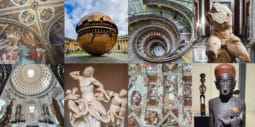

989440 travellers read
Via del Corso is one of Rome’s most renowned and vibrant shopping streets, located in the heart of the city. Stretching from Piazza del Popolo to Piazza Venezia, this historic thoroughfare offers a captivating shopping experience with a blend of international brands, luxury boutiques, fashionable stores, and traditional Italian shops. Via del Corso is the longest shopping street in Rome’s historic centre, measuring approximately 1.8 km (1.1 miles).
As you wander along this broad, pedestrian-friendly avenue, you’ll be charmed by elegant architecture, inviting cafés, and a lively atmosphere. Whether you’re on the hunt for designer fashion, unique souvenirs, artisanal products, or simply wish to enjoy the vibrant ambience of Rome’s retail scene, Via del Corso is a must-visit destination for both locals and visitors.
Contents
ToggleVia del Corso has a long and fascinating history that dates back to ancient Rome. Its origins can be traced to the Roman Empire, when it was known as the Via Lata, meaning “Broad Street”, a reference to its impressive width. It served as a vital artery, connecting the northern gate of the city, Porta Flaminia (now Porta del Popolo), to the southern gate, Porta Capena. Via Lata played a crucial role in trade, military logistics, and the movement of people in and out of the city.
During the Renaissance and early modern period, the street was transformed and became known as Via del Corso, which translates as “Course Street” or “Racecourse Street”. The name is thought to derive from the horse and chariot races that were held along its length during festivals and celebrations. These races were especially popular during the Roman Carnival, when the street became a lively venue for such spectacles.
Via del Corso developed further in the 17th and 18th centuries, emerging as a centre of commerce, culture, and social life. Elegant buildings, noble residences, and grand palaces were constructed along the street, reflecting the architectural grandeur of the period. It gained popularity as a shopping destination, drawing in merchants, craftsmen, and traders who opened shops and boutiques to cater to the aristocracy and well-to-do visitors.
In the 19th and 20th centuries, Via del Corso became one of the city’s main thoroughfares and a central stage for Roman life. It played host to significant historical moments, including political demonstrations, public gatherings, and parades. Its importance was reinforced during the unification of Italy in the 19th century, symbolising progress and national identity.
Today, Via del Corso remains one of Rome’s most dynamic and well-frequented shopping streets, admired for its unique combination of history, retail, and daily Roman life. It continues to draw both locals and visitors with its wide range of shops, cafés, and restaurants, all set against the backdrop of Rome’s architectural splendour. As one of the capital’s most iconic avenues, Via del Corso stands as a living testament to Rome’s layered history and vibrant contemporary culture.
Read my tips on Where to Try the Best Street Food in Rome.
Via del Corso is a renowned shopping street that offers a diverse retail experience, blending international labels with Italian boutiques and local stores. Here’s a look at what you’ll find while shopping on Via del Corso, along with some notable brand names (all links below lead to Google Maps):
In addition to branded stores, Via del Corso features a variety of souvenir shops, bookshops, and gift boutiques offering unique items to remember your visit to Rome. The lively atmosphere, variety of local and global retailers, and the historical character of the street make shopping on Via del Corso a thoroughly enjoyable experience for both residents and travellers.
Read also about Castel Romano Designer Outlet in Rome.
Via del Corso in Rome is steeped in history and full of fascinating details:
Getting to Via del Corso in Rome is straightforward, as it lies in the heart of the city and is well-served by public transport. Here are the most convenient ways to reach it:
Author: Kate Zusmann
This website uses cookies. For more info read the cookies policy
RomeItaly.guide © 2025. Created with love by Roman experts and guides.